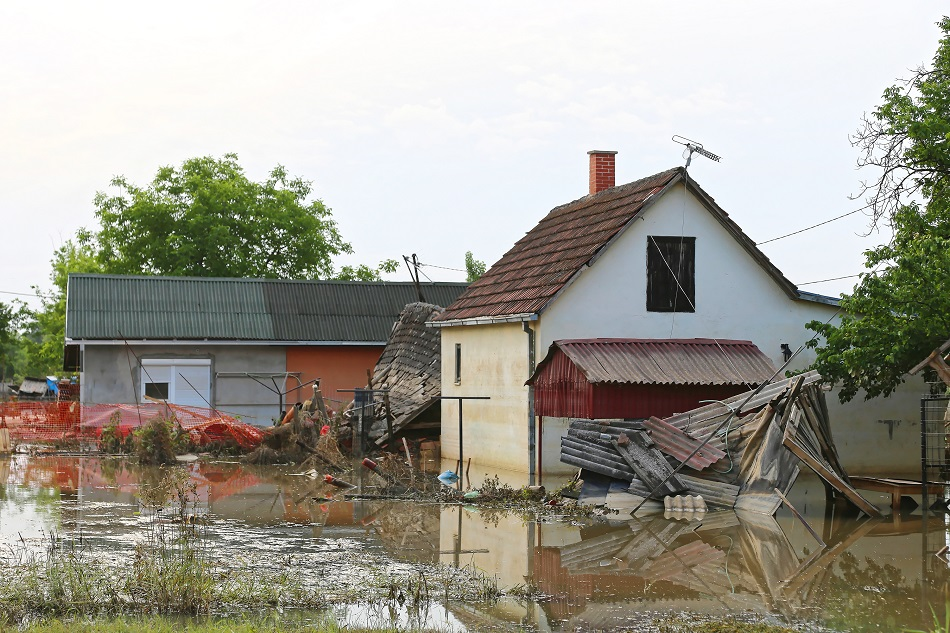
Image Credit: Baloncici/Shutterstock.com
Storms, flash floods, hurricanes, and even burst water mains can cause houses and buildings to be flooded. After the immediate flood danger has passed, cleaning up a flooded building poses numerous problems and unique dangers. Residual water may contain sewage, pesticides, and other waterborne organisms that can cause disease, as well as sharp objects and other debris. Caution should also be used when entering any flood-damaged structure.
Flooded Building Clean-up Safety Tips
The Restoration Industry Association (RIA) offers these safety tips for cleaning a building that has been flooded:
- Wear heavy rubber gloves, thick-soled boots, goggles, a hard hat, and an N95 dust mask.
- Enter the house only during daylight hours. Do not use candles or gas lanterns.
- Leave the house immediately if there is an odor of gas or any suggestion of instability in the structure.
- Change work clothes before entering any clean areas in a building to avoid cross-contamination.
- Wash work clothes separately from regular laundry.
- Drink plenty of fluids to stay hydrated. Rest frequently to avoid overheating and exertion.
- Wash hands and face frequently using an anti-microbial soap. Keep fingers away from eyes, nose, and mouth.
- Have a first-aid kit to hand. Treat cuts and abrasions immediately with an antibiotic ointment.
- If there is a boil-water advisory, boil water for washing for at least one minute or add 1 teaspoon of household bleach per gallon (3.8 liters) of water and let it stand for 30 minutes.
- Children, pregnant women, and people with health problems should avoid the flooded area until the clean-up is complete.
- Only use electrical equipment in dry environments to avoid the risk of electrical shock.
- If the power is off, turn the main electrical breaker off and tape it down to prevent it from accidentally turning on when the power is restored.
- Turn off natural gas at the meter and fuel oil or propane valves at the tank.
- Circulate fresh air throughout the house. Open doors, windows, closets, and cabinets.
- Remove all contents from areas that were underwater and hose them down.
- Double-bag and discard all food items.
- Discard rugs, mattresses, pillows, upholstered furniture, and other porous materials that have been affected by water.
- List and photograph damaged contents during removal.
- Washable garments, towels, and linens can be laundered in hot water and detergent. Items with visible mold are not restorable.
- Discard refrigerators and other appliances that contain internal insulation.
- Hard items such as metal, glass, china, and finished wood may be decontaminated and restored.
How to Clean and Dry a Flooded Building
What to do if your home or business suffers water damage:
- If the outside temperature is above 60°F, use dehumidifiers if available.
- Use fans to circulate the air and assist drying.
- Remove as much water as possible by mopping and blotting.
- Wipe furniture dry.
- Lift draperies off the carpet, loop through a coat hanger, and place the hanger on the drapery rod.
- Prop up wet furniture cushions for even drying and place small wood blocks or aluminum foil under furniture legs.
- Remove wet area rugs or other floor coverings and open furniture drawers, closet doors, and luggage to enhance drying.
- Move photos, paintings, and art objects to a safe, dry location.
- Remove wet fabrics and dry them as soon as possible. Hang furs and leather goods to dry separately at room temperature.
- Remove damp books from shelves and spread them out to dry.
- If damage occurs during a cool season, leave the heat on; if in summer, use an air conditioner if available.
Professional Help
Do not wait to call for professional help. Damage from the water and bacteria growth can begin within hours. Water damage restoration is an emergency business.
Things to Avoid when Cleaning after a Flood
This is what not to do after a flood:
- Do not use an ordinary household vacuum to remove water.
- Do not use electrical appliances while standing on a wet carpet.
- Do not go into rooms with standing water if the electricity is still on.
- Do not lift tacked-down carpet without professional help. Lifting the carpet incorrectly could promote shrinkage.
This article was updated on 24th February, 2020.
Disclaimer: The views expressed here are those of the author expressed in their private capacity and do not necessarily represent the views of AZoM.com Limited T/A AZoNetwork the owner and operator of this website. This disclaimer forms part of the Terms and conditions of use of this website.